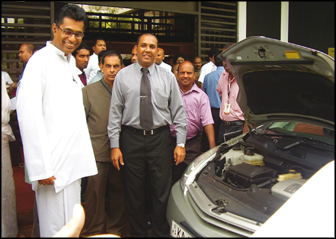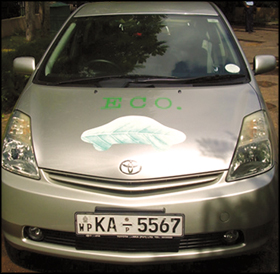Green Transport
by Patali Champika RANAWAKA
 |
|
Minister Patali
Champika inspects a modern car. |
When I was in Rome in 2008, on a private visit, I happened to
participate in a series of meetings and cultural events in Milan, Neples
and Rome, organized by the Sri Lankan expatriates. In Rome, I visited
its waste management sites and found that only 40% of waste was being
properly recycled and disposed. The authorities there informed me that
due to the involvement of underworld elements, the waste management in
Nepals was much worse compared to that in Rome and Milan. Although, they
had experienced similar problems that we were facing in Sri Lanka in the
field of waste management, they had been much better than us.
In Rome, my hosts - the Sri Lankan expatriates, had arranged a guided
tour of the old city of Pompeii, which had been devastated by volcanic
flow of lava from the eruption of Mount Vesuvius. The mummified human
bodies, trees, houses, streets and many other places I happened to see
there, prompted me to an unprecedented outburst of feelings. The rock
paved streets with wheel tracks of horse carriages and coaches there had
much resemblance to deeply cut modern railway tracks and they were
similar to the old Roman street ways I saw in England when I was there
on a visit, some time back.
These similarities raised my curiosity to observe a certain pattern.
The widths of the roads and the widths of the carriages are the same
in modern times although the modes of transportation have evolved
drastically. Once a friend of mine - a businessman, told me that the
Apollo Rocket was actually carried on the backs of two horses.
I was amused. When I inquired the reason for it I was told that
during the designing stage of the rocket, the scientists had seriously
considered as to how they could transport the rocket to its launching
pad. As they had decided to use the railway track to transport the
rocket the width of the rocket had been designed to suit the width of
the railway carriage. The present day carriage widths have been
standardized based on the carriages driven by two horses! Although,
horses are not used for modern day vehicles they are being designed to
the same scale and proportions!
During the conversation I have had with my friend on our way back
from Rome, we discussed about the soaring fuel prices that prevailed at
the time (2008) which was affecting almost all the economic activities
in the world. Was it due to the reasons of market manipulation or the
scarcity of resources? I thought it was due to both reasons,
notwithstanding the fact that the world was heavily dependent on oil.
We are experiencing the oil peak or the maximum oil production at
present, although it is expected to decline after 2015. Then what would
happen to the oil prices? The most important fact to remember is that
oil will no longer be a feasible source of energy as it will be
exhausted as a commercially viable commodity by 2050. After that what
would happen? Nobody seems to have found a satisfactory answer! However,
concepts like sustainable transport or green transport may shed some
light, leading to a possible solution.
It has been estimated that 20-25% of the world energy consumption and
the resulting emission of carbon, which causes global warming and
climatic change are due to transportation and the rate of its usage of
oil is faster than by any other energy using sector. In 1960, it was
estimated that nearly 200 million cars and other vehicles were being
used and 90% of these vehicles were owned by North America and Europe.
 However,
in 2005, the total number of cars used was nearly 800 million, whereas
60% of it was used in the western world. The rapied phase of development
in India and China has shown that the car industry in those super
economies is a booming industry. If we assume that India and China were
to achieve the same level of development and purchasing power of the
USA, then the oil reserves may exhaust by 2020! So, the mode of
transportation and the development are coupled to each other and share a
common limitation. However,
in 2005, the total number of cars used was nearly 800 million, whereas
60% of it was used in the western world. The rapied phase of development
in India and China has shown that the car industry in those super
economies is a booming industry. If we assume that India and China were
to achieve the same level of development and purchasing power of the
USA, then the oil reserves may exhaust by 2020! So, the mode of
transportation and the development are coupled to each other and share a
common limitation.
In addition to the economic cost of rising fuel prices, (once again
it is rising to 80 US$ per barrel) the transportation sector seriously
pollutes our environment.
The green house gas emissions from transportation is increasing at a
faster rate than from any other energy using sector like heavy
industries, agriculture or commerce.
The road transportation also contributes towards local air and sound
pollution. In addition to many other social problems, such as road
accidents, there are health hazards caused by air pollution, noise
pollution, physical inactivity and mental alienation.
Here the concept of alienation means the slavery of the human beings
towards their own constructions like cars, trains and aeroplanes. It
should also be noted that the fuel price increase would affect the most
vulnerable poor social groups who are not likely to own or drive cars.
It is a known fact that in addition to the waste of time and resources,
traffic congestion cause mental depression as well.
If we glance through the history of transportation, walking and
running are considered to be the first mode of transport which is also
most sustainable.
Later, the human beings were able to tame and obtain the services of
animals for transportation purposes. Buffaloes, Bulls, Camels, Donkeys,
Horses and even Elephants were properly trained and were used as
sustainable means of transport. It is reported that Chinese invented the
wheel and Indo-Europeans enhanced the technology by introducing spokes
etc. and had constructed carts and carriages. The boat and ship building
industry too was scaled up and developed during the war times and these
technologies were considered a significant leap forward.
Once again it was the Chinese who invented the know how of
transforming the linear motion into the circular motion which led to the
basic theory of modern combustion engines.
While the flying machine was developed by Wright Brothers, many
others contributed immensely for the development of aeronautic industry
and rocket science. The war played a vital role for the evolvement of
these technologies and therefore were based on reductionistic rather
than wholeistic sciences.
The public transport was introduced by Blaise Puscal by inventing the
public bus in 1662. The first passenger train and the first passenger
rail service began their operation in 1807, and in 1825, respectively.
The world sustainable transport came into being with the world
sustainable development. According to the EU Council of Ministers, the
sustainable transport or mobility means that which allows the basic
access and development needs of individuals, companies and society to be
met safely and in a manner consistence with human and eco system health
and promotes equity within and between successive generations.
Does affordable operators fairly and efficiently offer a choice of
transport mode, limits emissions and waste within the planetís ability
to absorb them, uses renewable resources at or below their rates of
generations and uses non renewable resources at or below the rates of
development of renewable substitutes while minimizing the impact on the
use of land and the generation of noise.
Currently 95% of the transport energy is generated from petroleum and
it contributes to 24% of the world energy related green house gas
emissions (in 2004) where about 75% of it emanates from road vehicles.
The citizens of the USA are the worse polluters and their passenger
transport per capita carbon dioxide emission is 4500 Kg., whereas, the
Western European Countries comparable figure is 1200 Kg. The Asian
passengers emit less than 500 Kg and the Sri Lankan figure is 200 Kg!
That clearly shows who the worse polluters and the least polluters are
when it comes to the question of world transportation.
The electric trams and trains are common modes of transport and
natural gas is also used as a source of energy. For their public
transport sector, India and Bangladesh had introduced LNG and bio fuels
are also used to a lesser extent. Brazil uses bio thermal and it meets
17% of its transport fuel needs.
A sustainable transport system should include not only the
introduction of green vehicles, but also it should include the related
urban designs, green infrastructure development like green ways, cycle
ways and public transport, access restrictions like car restricted
zones, parking managements, traffic calming, introducing pricing
strategies like city road pricing, integrated ticketing, travel
information, introducing proper urban goods transport system which
includes clean vehicles distribution scheme, fleet management etc.
Restricting air travel by introducing other communication
technologies, carbon natural airlines, introducing non transport
mitigatory measures like flexible working hours and flextime,
introducing new laws and most importantly political commitments and
public awareness about the danger we are going to face.
Green transport includes walking (also called ambulation), bicycling
or biking using of zero emission vehicles like battery powered, solar
powered or wind powered etc. Now hybrid vehicles are being introduced
and commonly used.
Animal powered or human powered modern transport vehicles are also
introduced. Whatever the means, the introduction of green transport is
essential. The scarcity of petroleum resources coupled with global
warming caused by burning of petroleum have forced us to change our mode
of transportation.
(The writer is the Minister of Environment and Natural Resources)
|

